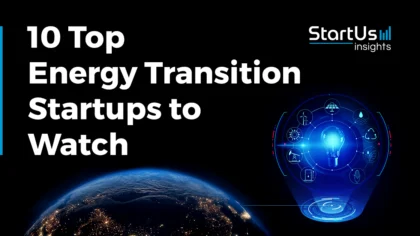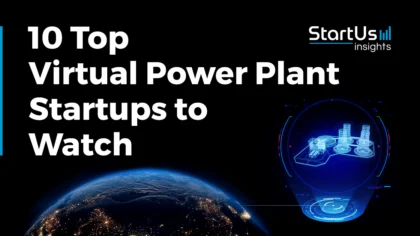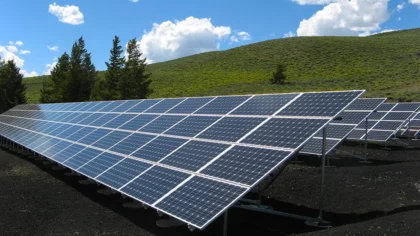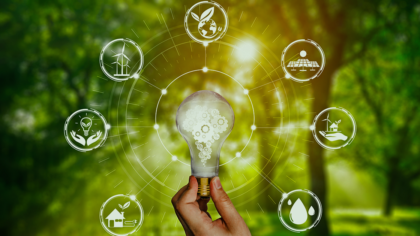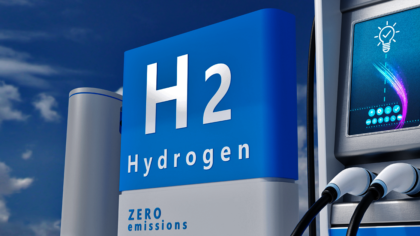Accelerate Productivity in 2025
Reignite Growth Despite the Global Slowdown
We’ve published a brand-new, data-rich report on the Latest Energy Industry Trends.
Read the Updated 2025 Energy Industry Trend Report!
The energy sector is undergoing rapid transformation driven by global legislation promoting sustainable energy sources and technologies for efficient energy systems. Current trends in the energy industry fall into three key concepts:
- Decarbonization focuses on transitioning to a clean, carbon-free economy by increasing the share of renewable energy sources, promoting electric mobility, and imposing higher taxes on fossil fuel usage.
- Decentralization involves geographically distributed electricity production to generate power independently from centralized distribution networks. This approach reduces energy intensity and maximizes the use of renewable energy sources.
- Digitization, known as Energy 4.0, involves the integration of digital technologies across all levels of the power system, from production and infrastructure to end-user devices. This digital transformation enables intelligent energy and power management solutions through advanced machine-to-machine (M2M) and machine-human interactions.
These trends collectively drive the energy sector towards a more sustainable, efficient, and resilient future.
This article was last updated in August 2024.
Innovation Map outlines the Top 10 Energy Industry Trends & 20 Promising Startups
For this in-depth research on the top energy industry trends and startups, we analyzed a sample of 2835 global startups & scaleups. This data-driven research provides innovation intelligence that helps you improve strategic decision-making by giving you an overview of emerging technologies in the energy industry. In the Energy Industry Innovation Map below, you get a comprehensive overview of the innovation trends & startups that impact your company.
Top 10 Trends in Energy (2025)
- Renewable Energy
- Internet of Energy
- Energy Storage
- Blockchain
- Energy as a Service
- Distributed Energy Resources
- Demand Side Management
- Quantum Computing
- Vehicle to Grid
- Power to X

These insights are derived by working with our Big Data & Artificial Intelligence-powered StartUs Insights Discovery Platform, covering 4.7M+ startups & scaleups globally. As the world’s largest resource for data on emerging companies, the SaaS platform enables you to identify relevant technologies and industry trends quickly & exhaustively.
Tree Map reveals the Impact of the Top 10 Energy Trends in 2025
The Tree Map below illustrates the top 10 energy industry trends that will impact companies in 2025. Renewable energy infrastructure development, power generation, storage, and efficiency drive innovations in the sector with numerous emerging companies developing low-cost renewable energy technology.
This, in combination with artificial intelligence (AI), the internet of energy, and blockchain account for nearly three-fourths of the energy industry trends. Advancements in electric vehicles (EVs) and charging solutions focus on enabling the transition to zero-emissions transportation by solving infrastructure-related challenges.
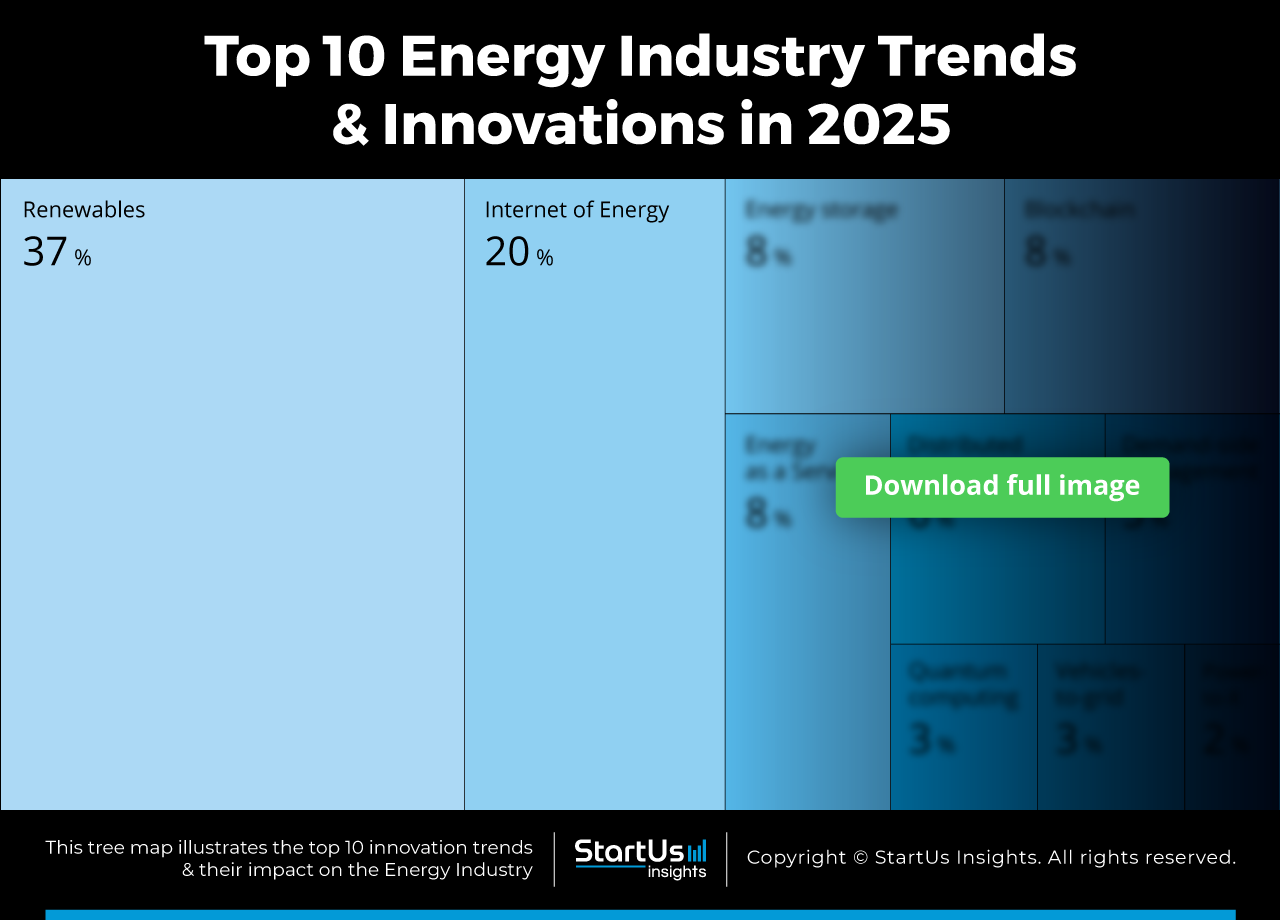
Global Startup Heat Map covers 2835 Energy Startups & Scaleups
The Global Startup Heat Map below highlights the global distribution of the 2835 exemplary startups & scaleups that we analyzed for this research. Created through the StartUs Insights Discovery Platform, the Heat Map reveals that the United States is home to most of these companies while we also observe increased activity in Europe, particularly in the UK.
Below, you get to meet 20 out of these 2800+ promising startups & scaleups as well as the solutions they develop. These 20 startups were hand-picked based on criteria such as founding year, location, funding raised, and more. Depending on your specific needs, your top picks might look entirely different.
Top 10 Energy Industry Trends in 2025
1. Renewable Energy
Shifting to renewable energy helps preserve the environment as it produces minimal to zero harmful emissions. The basic principle of using renewables is to extract them from a constant source in the environment, like the sun, the wind, or geothermal sources. Solar power technology is advancing with the development of more efficient photovoltaic cells, enabling higher energy conversion rates. Wind energy is evolving through the creation of larger, more efficient wind turbines, capable of harnessing energy even in low-wind conditions.
Additionally, advancements in hydroelectric power, such as compact, modular hydroelectric generators, are making this renewable source more accessible and less environmentally intrusive. These technologies collectively drive the shift towards cleaner, sustainable energy sources. The global renewable energy market size is expected to reach over USD 2182.99 billion by 2032, registering a CAGR of 8.5% from 2023-2032. This growth underscores the increasing adoption and investment in renewable energy technologies worldwide.
Odqa – Concentrated Solar Power (CSP)
British startup Odqa develops CSP technology that utilizes an ultra-high temperature solar receiver that enables high-temperature industrial heating processes. The solution unlocks high-temperature power cycles, increases production, and expands the capacity of photovoltaic (PV) power plants. They also offer a novel system layout for CSP plants that reduces the costs of PV plants and improves overall system efficiency.
Echoenergia – Wind Energy Generation
Echoenergia is a Brazilian startup that manufactures wind power generators with an operating capacity of 732 MW. The company develops a technology asset monitoring system called the Operations Control Center (OCC) to enable agile decision-making and improve safety. Echoenergia generates renewable energy from several wind complexes and matches individual project capacity to local demand, thus avoiding network congestion and unnecessary energy losses.
2. Internet of Energy (IoE)
Traditionally, electric power systems use a central architecture during construction that brings a new set of challenges to the industry. IoE addresses several of these challenges and offers greater efficiency. Smart meters enable real-time monitoring and management of energy usage.
IoT-based predictive maintenance systems in power plants and grids use sensors to detect potential equipment failures, preventing downtime and optimizing performance. Additionally, IoT-connected renewable energy sources, like solar panels and wind turbines, allow for remote monitoring and control, maximizing energy production and distribution.
Eniris – Smart Grid Controllers
Eniris is a Belgian startup that provides energy monitoring and control solutions for various sectors including renewable energy, building management, and engineering. Its solutions include device-agnostic and cloud-based EMS platforms and smart grid controllers. The startup enables solar farm operators, building managers, energy technology installers, and machine builders to monitor energy use and gain insights. For example, Eniris’ platforms collect data from devices like solar panels and sensors using various communication protocols.
Energeia – Energy Efficiency Solutions
Indian startup Energeia provides solutions for monitoring, identifying, financing, and implementing energy efficiency within a shared-savings business model. Energeia’s smart meters collect energy data using gateway devices and later send it to an online platform that analyzes this data, ultimately resulting in energy savings. The analytical engine generates consumption trends and predicts potential energy management improvements that it unlocks through changes in the grid process.
3. Energy Storage
Today’s technologies provide a sufficient level of generation, however, they lack cost-effective energy storage solutions. Energy storage enables stable pricing by proactively managing demand from consumers. By having the opportunity to purchase energy for future use, consumers potentially stock it up during ideal conditions. Lithium-ion batteries stand out for their high energy density and efficiency, widely used in both grid storage and electric vehicles.
Another innovative solution is flow batteries, offering longer discharge times and greater scalability for large-scale energy storage. Additionally, kinetic energy storage systems, like flywheels, provide rapid response energy storage, essential for stabilizing power grids. These technologies are key to integrating renewable energy sources, ensuring a stable and sustainable energy supply.
The energy storage market is estimated to be valued at USD 51.10 billion in 2025 and is expected to reach USD 99.72 billion by 2029, growing at a CAGR of 14.31% during the forecast period. This growth reflects the increasing demand for efficient and sustainable energy storage solutions.
Energy Vault – Long Duration Utility-Scale Energy Storage
Swiss startup Energy Vault develops energy storage technology that delivers around-the-clock baseload power from intermittent renewable energy sources, like solar and wind. Energy Vault’s ready-to-deploy solution is inspired by pumped-storage plants that rely on gravity and the movement of water to generate power. The elevation storage system is ideally suited for long-duration storage, and also provides faster response times.
STOREH Energy Storage – Hydrogen On Demand System
Italian startup STOREH Energy Storage Technologies builds energy storage devices to solve the challenges arising from intermittent production and constant consumption of power. Their hydrogen on-demand (HOD) system produces hydrogen without requiring compressors and tanks. Moreover, the company’s storage solution uses natural non-polluting materials such as zinc and water.
4. Blockchain
Blockchain technology intends to unite all energy stakeholders under a single decentralized network. Electricity producers, distribution network operators, metering operators, providers of financial services, and traders potentially benefit from utilizing smart contracts.
These contracts ensure that all energy-related transactions pass through a secure and immutable network, thus eliminating potential losses. Blockchain also holds the potential for achieving some degree of equality between energy producers and consumers by making electricity affordable for more people.
Blok-Z – Secure Green Energy Contracts
Turkish startup Blok-Z uses blockchain technology that enables anyone to be an energy market player with access to economical, transparent, and traceable green electricity. The Blok-Z software securely records ownership and consumption of electricity to automate settlement, auditing, and back-office processes.
Gideon One – Electricity Trading
Gideon One is a Thai startup that develops an electricity trading platform. It utilizes blockchain to facilitate secure, transparent, and efficient electricity trading between producers and consumers. The platform also integrates with smart meters to provide real-time energy production and consumption data, enabling automated and accurate billing. Further, it uses AI to match bids and offers to reduce energy wastage through re-matching algorithms and support day-ahead and intraday trading. By improving transactions and enhancing data transparency, Gideon One creates a sustainable and cost-effective energy market.
5. Energy as a Service (EaaS)
Some visions of the energy system in the future mainly revolve around DERs that are monitored by a combination of AI and IoT. Together with blockchain and a growing number of energy prosumers, these components comprise EaaS solutions. EaaS offers innovative solutions for energy management and efficiency. With energy performance contracts, service providers offer energy optimization in exchange for a portion of the energy savings.
The integration of renewable energy solutions, such as solar and wind power, into existing energy infrastructures, is also managed by EaaS providers. Additionally, EaaS companies are utilizing smart grid technologies to offer real-time energy monitoring and control, enhancing energy efficiency and reducing costs for consumers. These services are transforming how energy is managed and consumed, promoting sustainability and cost savings.
KPay – Energy Trading Platform
Indian startup KPay builds EaaS platforms that integrate with any electric device to enable energy trading. Their platform employs a pay-as-you-go model for solar, household appliances, pumps, and farming equipment. Three payment models – pay-per-use, pay-per-time, and pay-per-amp, provide customers with the flexibility to adjust their energy usage by factoring in the various benefits of each model.
Iota – AI-Powered Building Energy Services
The US-based startup Iota provides EaaS that includes their BrightAI smart building software in combination with a myriad of energy conservation measures. The solution optimizes energy management which includes lighting, HVAC, demand response, and renewable energy utilization. This EaaS approach simplifies the process of implementing an optimization strategy and reduces risk by guaranteeing savings. Moreover, the technology works independently of the analytics & communications platform that helps in reducing capital investments.
Find out how 10 emerging technologies shape your industry!
6. Distributed Energy Resources (DER)
Distributed energy resources enable the generation of electricity or heat at the place of its consumption. DERs are transforming the energy industry by enabling consumers to produce energy for their own needs and contribute excess power to the common grid. Examples include solar panels on residential and commercial buildings, which generate electricity and reduce reliance on centralized power sources.
Small-scale wind turbines, another form of DER, harness wind energy for local consumption and surplus distribution. Additionally, battery storage systems store excess energy generated by these units, ensuring a steady supply and optimizing the use of existing energy generation capacity. These innovations collectively reduce energy production costs and enhance the efficiency of energy utilization.
Ortus Energy – Power Purchase Agreements (PPA)
Ortus Energy is a UK-based startup that provides the Ortus Solar PPA, a PPA focused on solar energy. This product enables organizations to adopt clean, low-cost energy with no initial investment. Ortus Energy’s solar PV systems, installed on client premises, allow for the self-generation of green energy. This reduces electricity costs and carbon emissions. The Ortus Solar PPA includes system design, installation, monitoring, and maintenance — all enhance businesses’ environmental profiles and offer savings on energy bills.
Derapi – DER Integration into Energy Grids
US-based startup Derapi accelerates renewable energy development by making it easier for companies to connect distributed energy resources to the grid. It offers a uniform managed API layer that allows renewable companies to bring products to market faster, better serve customers, and reduce maintenance needs by simplifying code integration. This helps improve network reliability and security. The platform finds applications in DER management systems, microgrids, EV charging systems, and asset monitoring.
7. Demand Side Management (DSM)
DSM is becoming a vital trend in the energy industry, focusing on optimizing power system capabilities. Smart grid technology exemplifies DSM by balancing electricity demand and supply, particularly shifting consumption from peak to off-peak periods. Energy-efficient appliances and lighting systems represent another aspect, continuously reducing electricity consumption through advanced, efficient designs.
Additionally, home energy management systems, integrating IoT devices, allow consumers to monitor and control their energy usage actively, contributing to overall energy efficiency. These innovations collectively enhance the efficiency and sustainability of energy consumption.
Distributed Energy – Energy Asset Management
British startup Distributed Energy focuses on technologies that enable renewable energy adoption and efficiency. The company develops DSM solutions to manage small and medium-sized businesses’ power requirements. Their smart energy system provides easily accessible data on the energy usage of business assets and optimizes data collection across a range of machinery and assets.
BeChained – Demand Response for Industrial Manufacturers
Spanish startup BeChained focuses on demand response for industrial manufacturers. Its AI-driven platform enhances energy efficiency in production processes, enabling manufacturers to sell their demand-side flexibility in demand response markets. This not only reduces energy costs and CO2 emissions but also helps in managing energy demand more effectively. BeChained’s system is beneficial for manufacturers aiming to optimize energy usage and contribute to a more responsive and sustainable energy grid.
8. Quantum Computing
Quantum computing in the energy sector focuses on developing new energy solutions, improving energy efficiency, and reducing the use of greenhouse gases. One application is optimizing space allocation for energy infrastructure development, where quantum computing models analyze vast data sets more efficiently than traditional methods.
Another is in electricity generation planning, where quantum algorithms accurately predict and optimize generation units and schedules. Additionally, quantum computing aids in advanced material discovery for renewable energy technologies, accelerating the development of more efficient solar panels and batteries.
JoS Quantum – Cloud-Based Asset Management
German startup JoS Quantum develops cloud-based software solutions for energy asset management. The quantum-enabled algorithms solve complex issues for the energy sector involving risk analysis, portfolio optimization, and ML-powered enhancements. The company also provides research services to explore the potential of quantum computing and quantum-inspired algorithms in the energy sector.
QC Ware – Optimization Of Energy Utilization
The US-based startup QC Ware provides quantum computing solutions for optimizing energy utilization. Optimization and ML applications enable energy fault diagnosis, precise energy prediction, effective demand management, as well as asset risk analysis. The QC platform classifies data points using input datasets to carry out supervised learning. Later, it proceeds to execute these models on cloud-based simulators.
9. Vehicles to Grid (V2G)
V2G technology, a growing trend in the energy industry, allows electric vehicles (EVs) to interact with the power grid. EVs can sell energy back to the grid or modulate their charging rate in response to demand. This system transforms EVs into energy storage assets, utilizing their batteries to supply power through charging stations.
Charging EVs at lower costs during off-peak times aids the grid during high-demand periods. V2G solutions serve as flexible, accessible buffers, potentially reducing power outage durations. This technology is enhancing grid stability and promoting efficient energy use.
Fuergy – Virtual Energy Networks
Slovak startup Fuergy develops virtual energy networks of existing energy grids to achieve simultaneous energy balance using AI-powered energy-sharing systems. The company creates superchargers suitable for supporting the existing grid infrastructure. They provide electric vehicle charging and V2G functionalities to reduce energy costs and prolong battery life. Their solution uses the battery capacity of electric vehicles, connected to the grid, to improve energy variability and costs for building and vehicle owners alike.
Auto Motive Power – Electric Vehicle Charging Solutions
The US-based Auto Motive Power creates hardware and software solutions for electric vehicle charging. Their ampV2G software system enables EVs to charge, manage charging based on time or rate, and export electrical energy stored in the EV battery back to the local distribution network. This charging software runs on any operating system, including non-Linux, as it is optimized to run in small real-time microcontrollers.
10. Power to X
Power-to-X technologies are gaining traction in the energy industry as a means to reduce greenhouse gas emissions and improve energy efficiency. One key technology is power-to-gas, converting excess renewable energy into hydrogen or synthetic natural gas for storage or transportation.
Another innovation is power-to-liquid, transforming CO2 and renewable energy into synthetic fuels, useful in sectors where electrification is challenging. Additionally, power-to-chemicals processes use renewable energy and CO2 to produce green chemicals and materials, supporting a circular economy. These PtX technologies are pivotal in converting energy and CO2 into valuable products, diversifying renewable energy applications.
Ineratec – Power To Liquid
Swiss startup Ineratec provides customizable applications of gas-to-liquid, power-to-gas, and power-to-liquid technologies. Their gas-to-liquid process converts fossil fuel emissions and renewable methane-containing gases into synthetic hydrocarbons and fuels. Their power-to-gas system produces synthetic natural gas from regenerative hydrogen, carbon dioxide, as well as carbon monoxide. Additionally, their power-to-liquid solution converts renewable electricity and carbon dioxide into liquid fuels and other chemicals.
SeeO2 Energy – Gas To Fuel
Canadian startup SeeO2 Energy helps transform greenhouse gases (GHG) into assets by developing reversible fuel-cell technology. They convert synthetic gas, hydrogen, and carbon monoxide into alternative products like natural gas, methanol, ammonia, and synthetic liquid fuels. Besides, their technology enables the conversion of CO2 into marketable and clean value-added fuels and chemicals.
Discover all Energy Trends, Technologies & Startups
The energy sector faces increasing pressure from stakeholders to reduce the cost of renewables while simultaneously improving the adoption rate of renewable energy. Startups develop a range of solutions that cater to energy producers, consumers, as well as prosumers. Technologies to reduce the cost of solar and wind, increase the capacity of energy storage, and improve the efficiency of batteries generate exciting investment opportunities.
The energy industry trends and startups outlined in this report only scratch the surface of trends that we identified during our data-driven innovation & startup scouting process. Identifying new opportunities & emerging technologies to implement into your business goes a long way in gaining a competitive advantage.
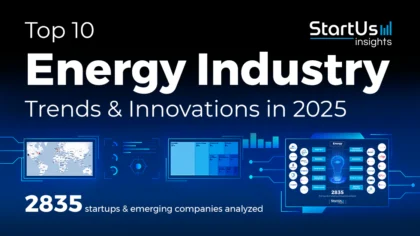

 WATCH THE VIDEO VERSION
WATCH THE VIDEO VERSION 


